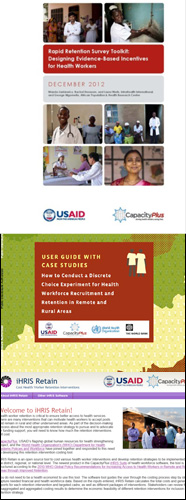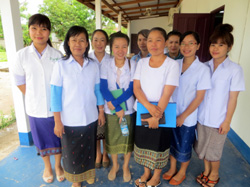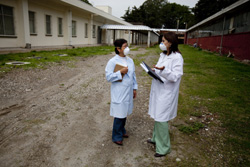
Supporting Country-Led Efforts to Recruit and Retain Health Workers and Improve Their Productivity
This post was originally published on the Global Health Workforce Alliance Members’ Platform. CapacityPlus is the featured member in March. We encourage you to join and contribute to the discussion. In recent years, heightened attention has been given to scaling up the production of health workers in response to the global human resources for health (HRH) crisis. While many countries face absolute health worker shortages and need to increase their availability, the HRH crisis is not just a supply problem. CapacityPlus provides technical assistance to ensure that health workers are more equitably distributed—especially to rural and other underserved areas, remain working at their posts, and effectively provide health care services in order to increase access to quality family planning, reproductive health, HIV and AIDS, and other primary health services and help countries move toward universal health coverage.
In recent years, heightened attention has been given to scaling up the production of health workers in response to the global human resources for health (HRH) crisis. While many countries face absolute health worker shortages and need to increase their availability, the HRH crisis is not just a supply problem. CapacityPlus provides technical assistance to ensure that health workers are more equitably distributed—especially to rural and other underserved areas, remain working at their posts, and effectively provide health care services in order to increase access to quality family planning, reproductive health, HIV and AIDS, and other primary health services and help countries move toward universal health coverage.
Vital to the agenda in this area of HRH systems strengthening is the need for an increased awareness of how the dynamics of the health labor market drive health worker shortages, maldistribution, and suboptimal performance. CapacityPlus is contributing to this agenda by collaborating with the World Bank and other partners to build the capacity of country stakeholders to conduct health labor market analyses to provide the evidence needed to develop effective policies that respond appropriately to the specific conditions influencing the movement of health workers within the labor market. The decision-making process to accept or leave a post in rural and underserved areas is complex and requires an understanding of the behavioral characteristics of the health workforce and the factors that motivate their employment decisions.
Listen to a nurse from the Democratic Republic of the Congo and a senior clinical officer from Uganda from CapacityPlus’s “I’m a Health Worker” video series describe some of the challenges that affect their motivation:
Addressing recruitment and retention  To aid countries in their recruitment and retention efforts, CapacityPlus developed several tools, based on the WHO’s global policy recommendations on rural retention, to provide stakeholders and HRH managers with step-by-step guidance and adaptable formats to select the most cost-effective strategies. The Rapid Retention Survey Toolkit describes a step-by-step approach to enable HRH managers to apply a discrete choice experiment to assess health workers’ motivational preferences. A free online eLearning course provides an overview of how to use the toolkit. In collaboration with the World Bank and the WHO, CapacityPlus created the User Guide with Case Studies: How to Conduct a Discrete Choice Experiment for Health Workforce Recruitment and Retention in Remote and Rural Areas to provide guidance to researchers and technical experts. Since knowing how much the incentive packages and other retention strategies will cost is a fundamental part of the decision-making process, CapacityPlus, in collaboration with the WHO, developed the companion software product iHRIS Retain. Part of the iHRIS suite of health workforce tools (to be the online discussion topic next week), the free, open source tool guides users through the costing process step-by-step to capture relevant financial and health workforce data, calculate the total costs, and compare the costs to available funding. The information is then used to determine which retention strategies would be the most cost-effective and to budget for implementation.
To aid countries in their recruitment and retention efforts, CapacityPlus developed several tools, based on the WHO’s global policy recommendations on rural retention, to provide stakeholders and HRH managers with step-by-step guidance and adaptable formats to select the most cost-effective strategies. The Rapid Retention Survey Toolkit describes a step-by-step approach to enable HRH managers to apply a discrete choice experiment to assess health workers’ motivational preferences. A free online eLearning course provides an overview of how to use the toolkit. In collaboration with the World Bank and the WHO, CapacityPlus created the User Guide with Case Studies: How to Conduct a Discrete Choice Experiment for Health Workforce Recruitment and Retention in Remote and Rural Areas to provide guidance to researchers and technical experts. Since knowing how much the incentive packages and other retention strategies will cost is a fundamental part of the decision-making process, CapacityPlus, in collaboration with the WHO, developed the companion software product iHRIS Retain. Part of the iHRIS suite of health workforce tools (to be the online discussion topic next week), the free, open source tool guides users through the costing process step-by-step to capture relevant financial and health workforce data, calculate the total costs, and compare the costs to available funding. The information is then used to determine which retention strategies would be the most cost-effective and to budget for implementation.  In Lao People’s Democratic Republic, findings from the Ministry of Health’s application of the Rapid Retention Survey Toolkit and iHRIS Retain, with technical support from CapacityPlus and the WHO, informed the new national recruitment and retention policy for the health workforce. The policy stipulates that all new graduates in medicine, nursing, midwifery, pharmacy, and dentistry, as well as postgraduates in family medicine, must complete three years of compulsory rural service in order to receive their licenses to practice. The policy also provides specific incentives, based on the survey and costing results, to motivate health workers to provide high-quality services while carrying out their rural service, as well as encourage them to stay after the compulsory service has ended. Incentives include permanent civil service positions, transportation, and eligibility for continued education. The first phase of the policy, initiated in 2013, placed 400 newly qualified doctors, pharmacists and dentists in almost one-third of the country’s rural districts.
In Lao People’s Democratic Republic, findings from the Ministry of Health’s application of the Rapid Retention Survey Toolkit and iHRIS Retain, with technical support from CapacityPlus and the WHO, informed the new national recruitment and retention policy for the health workforce. The policy stipulates that all new graduates in medicine, nursing, midwifery, pharmacy, and dentistry, as well as postgraduates in family medicine, must complete three years of compulsory rural service in order to receive their licenses to practice. The policy also provides specific incentives, based on the survey and costing results, to motivate health workers to provide high-quality services while carrying out their rural service, as well as encourage them to stay after the compulsory service has ended. Incentives include permanent civil service positions, transportation, and eligibility for continued education. The first phase of the policy, initiated in 2013, placed 400 newly qualified doctors, pharmacists and dentists in almost one-third of the country’s rural districts.
Improving health workforce productivity Even as countries implement medium- and long-term workforce expansion strategies, they can maximize health system performance in the meantime through more efficient service delivery and improved productivity and performance of currently available health staff. How effectively the health workforce performs and uses other health systems inputs will contribute to improving health systems performance and, consequently, health outcomes. To assist countries in improving health workforce productivity, CapacityPlus is developing a Health Worker Productivity Analysis and Improvement Toolkit. The toolkit is designed to empower managers and supervisors to measure health workforce productivity, identify productivity problems and their underlying causes, and determine appropriate interventions to improve health worker productivity within their respective facilities. In collaboration with the WHO/Lao People’s Democratic Republic, CapacityPlus supported the Ministry of Health to field-test the toolkit in 12 district health facilities and three hospitals in Bolikhamxay Province and identify possible interventions to improve efficiency of health services and increase patient demand. CapacityPlus is also developing a course for USAID’s Global Health eLearning Center to orient learners on health workforce productivity. If you would like to be notified when the toolkit and course are available, please contact us.
Even as countries implement medium- and long-term workforce expansion strategies, they can maximize health system performance in the meantime through more efficient service delivery and improved productivity and performance of currently available health staff. How effectively the health workforce performs and uses other health systems inputs will contribute to improving health systems performance and, consequently, health outcomes. To assist countries in improving health workforce productivity, CapacityPlus is developing a Health Worker Productivity Analysis and Improvement Toolkit. The toolkit is designed to empower managers and supervisors to measure health workforce productivity, identify productivity problems and their underlying causes, and determine appropriate interventions to improve health worker productivity within their respective facilities. In collaboration with the WHO/Lao People’s Democratic Republic, CapacityPlus supported the Ministry of Health to field-test the toolkit in 12 district health facilities and three hospitals in Bolikhamxay Province and identify possible interventions to improve efficiency of health services and increase patient demand. CapacityPlus is also developing a course for USAID’s Global Health eLearning Center to orient learners on health workforce productivity. If you would like to be notified when the toolkit and course are available, please contact us.
For discussion
Here are some questions to get the conversation started. Please feel free to respond to any or all or just to make general comments or add your own questions. We are eager to hear from you and look forward to your comments and reflections!
- What experiences and lessons learned can you share from your country’s or organization’s efforts to improve HRH distribution and productivity?
- What policy options are being implemented in your country to increase access to health workers in rural and underserved areas and ensure a high level of productivity? How effective are these policy interventions in your specific health labor market context?
- What suggestions do you have for how we can better contribute to moving the HRH agenda forward and assist countries to address challenges in recruitment, retention, and productivity?
Help CapacityPlus spread the word about strengthening the health workforce. Follow us on Twitter and like us on Facebook.
Related items:
Author photo courtesy of Wanda Jaskiewicz; photo of health workers in Lao PDR by Wanda Jaskiewicz; photo of health workers in Guatemala by Trevor Snapp/courtesy of IntraHealth International


